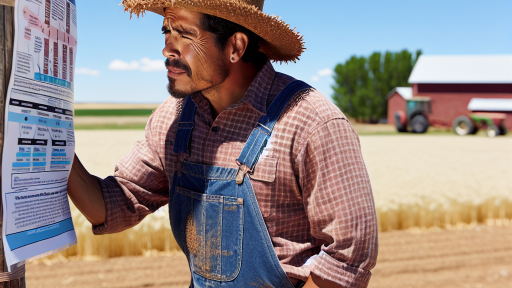Understanding the Basics of Agricultural Grants and Loans
Introduction to Agricultural Financing
Agricultural financing plays a key role in the farming sector.
Farmers often rely on grants and loans to grow their businesses.
These financial resources help with purchasing land, equipment, and supplies.
What Are Agricultural Grants?
Agricultural grants are funds given to farmers that do not need to be repaid.
They often support specific projects or initiatives.
For instance, some grants may focus on sustainability or technology adoption.
Farmers must usually apply and meet certain criteria to qualify.
Types of Agricultural Grants
Various types of grants exist for farmers.
- Federal grants often come from government agencies.
- State grants may be available through local programs.
- Private grants can be offered by organizations and foundations.
What Are Agricultural Loans?
Agricultural loans are borrowed money that needs to be repaid.
These loans typically have fixed or variable interest rates.
Farmers can use loans for various purposes, including expansion and operational costs.
Repayment terms can vary depending on the lender and loan type.
Types of Agricultural Loans
Multiple categories of loans are available to farmers.
- Conventional loans are provided by banks and credit unions.
- Government-backed loans help reduce risk for lenders.
- Microloans offer smaller amounts for specific needs.
Applying for Grants and Loans
Applying for agricultural grants and loans requires preparation.
Farmers should gather necessary documentation before applying.
Transform Your Agribusiness
Unlock your farm's potential with expert advice tailored to your needs. Get actionable steps that drive real results.
Get StartedThis might include business plans, financial statements, and project proposals.
Understanding the application process is also crucial for success.
Common Application Requirements
Each grant or loan program may have unique requirements.
- Eligibility criteria often include farm size and income levels.
- Documentation requirements typically involve proof of land ownership.
- Application deadlines may vary, so it is essential to stay informed.
Importance of Agricultural Financing for Growth
Understanding grants and loans can significantly impact a farmer’s success.
With proper knowledge and preparation, farmers can access valuable resources.
This financial support fosters growth and sustainability in agriculture.
Types of Financial Assistance Available for Farmers
Grants
Grants provide funding that does not require repayment.
Farmers can use these funds for various purposes.
Common uses include equipment purchases and research initiatives.
Additionally, grants support sustainable farming projects.
Many federal and state programs offer grant opportunities.
Farmers should check eligibility requirements before applying.
Loans
Loans require repayment but can provide substantial funding.
Farmers often use loans for land purchases or operational costs.
The U.S. Department of Agriculture (USDA) offers several loan programs.
These programs cater to different needs and situations.
Interest rates and terms vary based on the program.
Farmers can explore options to find a suitable loan.
Cost-Share Programs
Cost-share programs help offset expenses for specific projects.
These programs typically cover a percentage of project costs.
Common examples include conservation and soil health initiatives.
Farmers can apply for cost-share assistance through various agencies.
These programs often have specific eligibility criteria.
Tax Incentives
Tax incentives provide financial benefits for farmers.
Showcase Your Farming Business
Publish your professional farming services profile on our blog for a one-time fee of $200 and reach a dedicated audience of farmers and agribusiness owners.
Publish Your ProfileEligible expenses may qualify for tax deductions or credits.
Common deductions include equipment depreciation and conservation practices.
Farmers should track expenses throughout the year for maximum benefits.
Consultation with a tax professional can enhance understanding.
Specialized Programs
Specialized programs target specific needs or challenges.
For instance, disaster relief programs aid farmers affected by calamities.
Additionally, programs exist for organic farming support.
Veterans and minority farmers may find unique financial assistance options.
Careful research will help farmers discover available programs.
Navigating the Application Process for Grants
Understanding Grant Opportunities
Farmers must first identify potential grant opportunities.
Various organizations and government bodies offer grants tailored for agriculture.
Research local, state, and federal programs that support farming initiatives.
Additionally, consider niche grants that may benefit specific types of farming.
Preparing Required Documentation
Before applying, gather essential documents for your application.
Documents typically include financial statements and business plans.
You may also need to present proof of eligibility and project viability.
Organizing your paperwork will streamline the application process.
Writing a Strong Proposal
Your proposal should clearly outline your project goals and objectives.
Start with a compelling introduction that grabs the reader’s attention.
Use clear language to describe how the grant will benefit your farm.
Support your claims with data and evidence from reliable sources.
Following Application Guidelines
Be sure to adhere to all specific guidelines provided by the grantor.
Double-check your application for any required fields and formats.
Missing information can lead to automatic disqualification.
Pay attention to deadlines to ensure timely submissions.
Seeking Feedback and Making Revisions
Consider asking peers or mentors to review your application.
Fresh eyes may catch errors or suggest valuable improvements.
Revising based on feedback can strengthen your proposal significantly.
Take the time to polish your document before submission.
Staying Organized Throughout the Process
Maintain a checklist of requirements and deadlines for each grant.
Stay proactive in following up on your application status.
Document all correspondence with grant organizations.
This will prove useful in case you need to address any issues later.
See Related Content: Common Mistakes When Applying for Farm Aid
Loan Options for Farmers: USDA and Private Financing
Overview of USDA Loans
The USDA offers various loan programs for farmers.
These loans support rural development and agricultural projects.
Farmers can access low-interest rates and favorable terms.
Additionally, these loans can help with purchasing equipment and land.
Types of USDA Loan Programs
There are several types of USDA loans available.
- Farm Ownership Loans help purchase or improve farm land.
- Operating Loans assist with day-to-day farming expenses.
- Emergency Loans provide funds after a natural disaster.
- Conservation Loans support environmentally friendly practices.
Eligibility Requirements for USDA Loans
Farmers must meet specific requirements to qualify for USDA loans.
Showcase Your Farming Business
Publish your professional farming services profile on our blog for a one-time fee of $200 and reach a dedicated audience of farmers and agribusiness owners.
Publish Your ProfileFirst, they must operate in a rural area as defined by the USDA.
Additionally, they need a solid credit history and feasible business plan.
Furthermore, borrowers may need to demonstrate farming experience.
Exploring Private Financing Options
In addition to USDA loans, private financing is available.
Many banks and credit unions offer agricultural loans.
Farmers can benefit from competitive interest rates and terms.
Moreover, private lenders may provide tailored financing solutions.
Types of Private Loans
Farmers can choose from different private loan types.
- Term loans provide a lump sum for large purchases.
- Lines of credit offer flexible borrowing for operating expenses.
- Equipment financing specifically covers the purchase of machinery.
- Real estate loans assist with acquiring agricultural property.
Evaluating Private Lender Options
It’s crucial to evaluate potential private lenders carefully.
Farmers should compare interest rates and repayment terms.
Additionally, customer service quality and lender reputation matter.
Networking with other farmers can provide valuable recommendations.
Combining USDA and Private Financing
Farmers can combine USDA loans with private financing effectively.
This strategy can enhance cash flow and reduce financial burdens.
Moreover, it allows for greater investment in farm operations.
Ultimately, a diverse financing portfolio can lead to growth.
Discover More: Benefits of Government Aid for Farmers
Documentation Required for Grant and Loan Applications
Basic Identification Documents
Farmers must provide valid identification for all applicants.
This usually includes a government-issued ID or driver’s license.
Additionally, social security numbers are often required.
Ensure these documents are current and legible.
Business Plan and Financial Statements
A detailed business plan is essential for securing funding.
This plan should outline your farming operations, goals, and strategies.
Include projected financial statements for a well-rounded view.
Balance sheets, income statements, and cash flow projections are vital.
Proof of Farm Ownership or Lease Agreements
Applicants must show proof of farm ownership or a valid lease.
This documentation establishes your operational credibility.
Leases should detail the duration and terms clearly.
Tax Returns and Profitability Documentation
Provide copies of your recent tax returns for the past three years.
This information helps assess your financial stability.
Include any documentation proving profitability from your farm.
Credit History Reports
A comprehensive credit history is often necessary for loans.
This report should reflect your creditworthiness and repayment potential.
It’s beneficial to check your credit score to address issues beforehand.
Supporting Documents for Grants
Grants typically require additional supporting documents.
These might include letters of support from community organizations.
Research proposals or innovation plans may also be relevant.
Submit any data that demonstrates community impact or need.
Compliance Certificates
Many applications require compliance with local regulations.
Document any environmental assessments or agricultural permits.
Showcase Your Farming Business
Publish your professional farming services profile on our blog for a one-time fee of $200 and reach a dedicated audience of farmers and agribusiness owners.
Publish Your ProfileThis verifies adherence to farming standards and sustainability practices.
Application Forms and Fees
Finally, complete all application forms as instructed.
Ensure that all required fees are paid on time.
Submit your application before the deadline to avoid disruptions.
Gain More Insights: How New Trade Policies Are Impacting U.S. Farmers and Exports

Tips for Writing a Successful Grant Proposal
Understand the Grant Program
Research the specific grant program you are targeting.
Identify its goals and eligibility requirements.
Ensure your project aligns with their mission.
Familiarize yourself with past successful proposals.
This knowledge can guide your writing process.
Develop a Clear Project Outline
Start by outlining your project’s objectives.
Clearly define the problem your project addresses.
Include a detailed plan of action.
Break down tasks into manageable steps.
Specify timelines and milestones for your project.
Demonstrate Impact and Feasibility
Clearly articulate the potential impact of your project.
Provide data and examples to support your claims.
Discuss how you will measure success throughout the project.
Address any potential challenges and how you will overcome them.
Budget Planning
Create a realistic and detailed budget for your project.
Justify each expense and its relevance to the project.
Consider future funding needs beyond the grant period.
Showcase any additional financial support you have secured.
Follow Application Guidelines
Carefully read and follow the grant application guidelines.
Adhere to formatting and submission requirements.
Pay attention to word limits and required documents.
Submit your proposal well before the deadline.
Seek Feedback
Before submitting, seek feedback from colleagues or mentors.
They can provide valuable insights and suggestions.
Incorporate their feedback to improve your proposal.
A fresh perspective can highlight areas for clarity.
Stay Persistent
Be prepared for rejection and learn from it.
Analyze feedback and improve your future proposals.
Consider applying for other funding opportunities.
Persistence can lead to eventual success.
Explore Further: Navigating New Water Rights Policies: What It Means for Farmers
Common Mistakes to Avoid When Applying for Agricultural Funding
Neglecting Research
Many farmers fail to conduct adequate research before applying for funding.
Understanding the type of funding available is crucial.
Identifying the specific requirements of each program can save time and effort.
Moreover, knowing the deadlines helps ensure timely submissions.
Showcase Your Farming Business
Publish your professional farming services profile on our blog for a one-time fee of $200 and reach a dedicated audience of farmers and agribusiness owners.
Publish Your ProfileIgnoring Eligibility Criteria
One common mistake is ignoring the eligibility criteria outlined in funding applications.
Every program has specific requirements that applicants must meet.
Failing to confirm eligibility can lead to immediate rejection.
It is essential to read all guidelines carefully before applying.
Submitting Incomplete Applications
Submitting incomplete applications is a frequent error among first-time applicants.
Incomplete documents can result in disqualification.
Double-check all required materials before submission to avoid this problem.
Additionally, using a checklist can ensure all necessary documents are included.
Overlooking Financial Statements
Farmers often overlook the importance of accurate financial statements.
Funding agencies require clear and detailed financial documentation.
Including accurate data enhances the credibility of the application.
Furthermore, well-prepared financial reports can demonstrate the farm’s viability.
Not Seeking Assistance
Many farmers hesitate to seek assistance when applying for funding.
However, consulting with experts can provide valuable insights.
Local agricultural extension offices can offer guidance and resources.
Additionally, networking with other farmers can uncover helpful experiences.
Failing to Follow Up
After submitting an application, failing to follow up is a missed opportunity.
Checking in can provide updates on the application’s status.
Moreover, expressing continued interest can keep the application top of mind.
Persistence can sometimes sway decisions in favor of the applicant.
Resources and Organizations that Assist Farmers in Securing Funding
Government Grants
Various government programs provide funding for farmers.
The USDA offers numerous grants for specific agricultural projects.
Additionally, the Small Business Administration supports rural business initiatives.
State governments often have local grants tailored for their farming communities.
Nonprofit Organizations
Many nonprofit organizations focus on agricultural support.
For instance, the Rodale Institute promotes sustainable farming through grants.
Farm Aid offers financial assistance and resources for struggling farmers.
Finally, the National Sustainable Agriculture Coalition advocates for farmer-friendly policies.
Farm Credit Services
Farm Credit Services provides loans specifically designed for farmers.
They offer various types of loans, including operational and equipment financing.
Furthermore, they understand the unique needs of the agricultural sector.
Local Agricultural Extension Offices
Every state hosts agricultural extension offices that offer assistance.
These offices provide valuable resources and funding information.
They also facilitate connections with local funding programs.
Online Platforms
Several online platforms collate available grants and loans for farmers.
Websites like Grants.gov and AgriFunding.com serve as valuable resources.
Moreover, farmers can use these platforms to apply for funding directly.
Workshops and Training Programs
Many organizations conduct workshops to educate farmers about funding options.
These programs often cover grant writing and loan applications.
Participation can enhance farmers’ chances of securing funding.
Showcase Your Farming Business
Publish your professional farming services profile on our blog for a one-time fee of $200 and reach a dedicated audience of farmers and agribusiness owners.
Publish Your ProfileAdditional Resources
5 USDA Grants and Loans for Farms, Ranches and Land Managers




